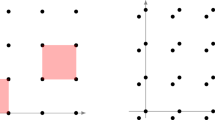Abstract
In this article, we examine Rational Blaschke functions to create the Multiresolution analysis on the Hardy space \(H_{2} (\mathbb {T})\). We discuss a decomposition using a non-Blashke sequence, which is analogous to the Whitney cube decomposition of the unit disc. Our primary goal is to successfully recreate an analytic function from samples at the non-Blaschke sequence. We explore the Banach frame structure that was produced from the non-Blaschke sequences, look at the frame structure of the reproducing kernel that corresponds to it, and derive a series representation of any operator in the space in terms of the sampling sequence.

Similar content being viewed by others
References
Akrami, F., P.G. Casazza, M.A. Hasankhani Fard, and A. Rahimi. 2023. A note on norm retrievable real Hilbert space frames. Journal of Mathematical Analysis and Applications 517(2): 126620.
Aldroubi, A., et al. 2017. Dynamical sampling. Applied and Computational Harmonic Analysis 42(3): 378–401.
Bokor, J., and F. Schipp. 1998. Approximate linear \(H_{\infty }\) identification in Laguerre and Kautz basis. IFAC Automatica Journal 34: 463–468.
Casazza, P.G., D. Han, and D.R. Larson. 1999. Frames for Banach spaces. Contemporary Mathematics 247: 149–182.
Christensen, O. 2003. An introduction to Frames and Riesz basis. Basel: Birkhäuser.
Fridli, F. 2011. Schipp, Biorthogonal systems to rational functions. Annales Univ. Sci. Budapest., Sect. Comp 35(1): 95–105.
Fridli, S., and F. Schipp, 2011. Rational function systems in ECG processing, Computer Aided Systems Theory—EUROCAST, Lecture Notes in Computer Science.
Hangos, K.M., and L. Nadai (eds.). 2009. Proceedings of the Workshop on System and Control Theory. Budapest: Budapest University of Technology and Economics, Computer and Automation Research Institute of HAS.
Heuberger, S.C., P.M.J. Van den Hof, and B. Wahlberg. 2005. Modelling and identification with rational orthogonal basis functions. New York: Springer-Verlag.
Klauder, J. R. 1963. Continuous representation theory. I. Postulates of continuous representation theory. Journal of Mathematical Physics 4(8): 1055-1058.
Kovacs P., and L. Locsi. 2012. RAIT: The rational approximation and interpolation toolbox for Matlab. In 35th International Conference on Telecommunications and Signal Processing, 671–677.
Lorentz, G.G., M. Golitschek and Y. Makozov. 1996. Constructive approximation. In Advanced Problems, Grundlehren der Mathematischen Wissenschaften, vol. 304, Berlin: Springer-Verlag.
Noufal, A. 2018. Study of multiplication operator on \({\cal{H}}_{\frac{1}{2}}\oplus {\cal{H}}_{-\frac{1}{2}}\). International Journal of Applied and Computational Mathematics, 4, 144.
Pap, M. 2011. Hyperbolic wavelets and multiresolution in \(H^{2}({\mathbb{T} })\). Journal of Fourier Analysis and Applications 17(5): 755–776.
Pap, M., and F. Schipp. 2006. The voice transform on the Blaschke group I. Pure Mathematics and Applications 17(3–4): 387–395.
Pap, M., and F. Schipp. 2008. The voice transform on the Blaschke group II. Annales Universitatis Scientiarum Budapestinensis Section Computing 29: 157–173.
Partington, J. 1997. Interpolation, Identification and Sampling. London Mathematical Society Monographs, vol. 17. London: Oxford University Press.
Speransky, K.S., and P.A. Terekhin. 2019. Existence of frames based on the Szego Kernel in the Hardy space. Russian Mathematics 63(2): 51–61.
Takenaka, S. 1925. On the orthogonal functions and a new formula of interpolation. Japanese Journal of Mathematics 2: 129–145.
Totik, V. 1984. Recovery of Hp-functions. Proceedings of the American Mathematical Society 90: 531–537.
Acknowledgements
The authors acknowledge Dr. Margit Pap, Associate Professor, Department of Mathematics, University of Pecs for fruitful discussions in this research direction. Anusree Sreedharan wishes to thank Cochin University of Science and Technology for the PhD fellowship.
Author information
Authors and Affiliations
Corresponding author
Ethics declarations
Conflict of interest
The authors declare that they have no conflict of interest.
Additional information
Communicated by S. Ponnusamy.
Publisher's Note
Springer Nature remains neutral with regard to jurisdictional claims in published maps and institutional affiliations.
Rights and permissions
Springer Nature or its licensor (e.g. a society or other partner) holds exclusive rights to this article under a publishing agreement with the author(s) or other rightsholder(s); author self-archiving of the accepted manuscript version of this article is solely governed by the terms of such publishing agreement and applicable law.
About this article
Cite this article
Sreedharan, A., Asharaf, N. Frame structure derived from a non-Blaschke sequence on the unit disc. J Anal (2024). https://doi.org/10.1007/s41478-023-00705-0
Received:
Accepted:
Published:
DOI: https://doi.org/10.1007/s41478-023-00705-0




